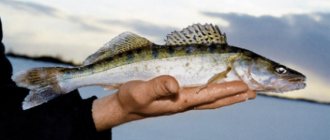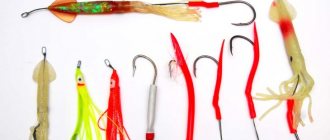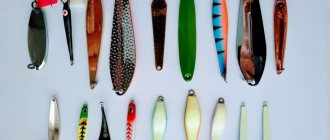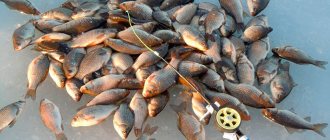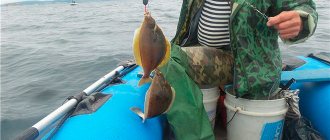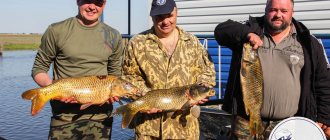home
Fishing
Catching carp on Akhtuba
Carp (wild carp) is a delicious river fish. Its size is large; sometimes individuals weigh up to 20 kg. The carp on Akhtuba is a schooling fish, its body is elongated, scaly (powerful scales), and high. The color may vary slightly - from light golden to dark bronze. Large individuals that constantly live in the deep waters of the Akhtuba river have a cigar-shaped body. In stagnant water there are individuals with a hump on their back. It is not easy to catch such fish; they are restive and nimble.
Wild river carp have excellent hearing, as they have a hypersensitive “midline” of the body. Even one awkward movement by a fisherman can scare away the carp. If you create artificial noise at the depth of a reservoir, it will practically not disturb it, but extraneous noises (knocks, creaks) will discourage the carp, which is found in Akhtuba, from the fishing spot if the fishing process is on a boat.
When and where to fish?
Fishing on Akhtuba from mid-April (fishing is advisable until mid-September). But the most trophy fishing occurs at the end of June to the end of August. You can fish for restive fish in different ways.
For fishing with fishing rods near the river bank, it is better to choose:
- Bridge, piles, cliff with ancient trees. These places are covered with silt and overgrown with mud, attracting river representatives of the carp family.
- A hole, a ditch with a depth of 15 meters is a favorite habitat. Fish enter from here only to feed.
- A plant that grows in water. River horsetail and arrowhead produce oxygen. Here wild carp likes to live permanently because it finds a lot of food.
Gear selection
The fight against trophy fish involves the use of powerful gear. To catch carp you can use carp or feeder rods. Many amateur fishermen also use a regular donkey based on a durable Chinese spinning rod of the “Crocodile” type, it all depends on the budget and passion of each carp angler.
In any case, the rod must be reliable and meet the characteristics of the bait and the line tensile test. Exceeding the test indicators is fraught with damage to the form and, as a result, a spoiled mood.
The reel must be able to wind a large amount of fishing line with a solid diameter, according to the Shimano-Daiwa classification this is 4000-5000. In addition, it must have a clearly adjustable clutch, and in the best case, a baitrunner.
A fishing line for fighting carp must be chosen that is especially strong; usually a monofilament of 0.35-0.40 in diameter is used. Braided fishing line is not suitable for fighting a trophy due to its low elongation, but it can be used as a shock leader.
To install fishing rods, use a reliable rod
Attention! Shock leader is an insert made of thick durable monofilament or braid between the main line and the equipment. It helps cast heavier loads, prevents abrasion, and helps with fishing. The usual length of the segment is 2-3 linear rod sizes.
Equipment for catching carp can be different:
- hair installation with leadcore and a safe clip;
- flat type feeder;
- any of the feeder installations;
- crown;
- pacifier.
It all depends on how we usually catch, who likes what more.
In addition to gear, when going to Akhtuba, you need to take additional equipment with you:
- landing net;
- cage;
- a type of pod or other stands for fishing rods;
- bite alarms;
- folding chair or stool;
- set of fishing tools: knife, extractor, boilie needle, pliers;
- bait supplies;
- other fishing stuff.
A boat will also come in handy on the river; with its help you can study the terrain, bring in bait, and cross the river. And just fishing from a boat is quite interesting. True, in this case, side or float fishing rods are most often used, and carp are most often caught from the shore.
Where to fish from a boat
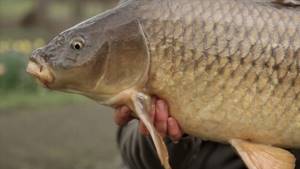
If you prefer to fish by boat rather than on the shore, choose your fishing spot as follows: River carp swim on top of the current. Therefore, the boat needs to be moored in this direction, preferably where the current is slow, here they rest and feed. Good fishing locations for fishing are where the boundaries between the shallows are. Wild carp choose places where the terrain is zigzag. It is best to fish at dawn and late in the evening, especially when weather conditions change, the fish jump out of the water perpendicularly up and back. Such playful jumping is accompanied by quite loud splashes on the river surface.
Where can you catch fish?
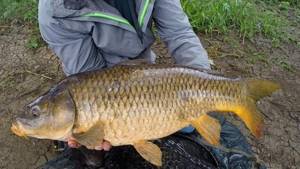
It is important to choose the right place where you will fish. Fishing for carp on the river most often occurs along the Volga, as well as in the territory of Astrakhan rivers and lakes. Carp is a freshwater fish, not particularly picky about the quality of water in the reservoir. The temperature of the reservoir and its flow rate are of greatest importance for it. Minor pollution is perceived by her as a slight discomfort, but nothing more.
If you go fishing for carp and carp, it will be interesting to know that the number of fish gradually increases as you move south. As for the local landscape, it will be useful to pay attention to coastal areas that are full of vegetation. Carp prefers to feed near submerged trees and snags; it loves plant foods, for example, water lilies or reeds.
Fishing for carp works well in flooded pits with a clay bottom - the fish feels quite comfortable in them, but it often avoids muddy and sandy places. The best bite will be in places with not very strong currents, and the depth of the reservoir does not exceed 4 - 6 meters.
Good places for catching carp on the river can be identified by carp circles. While exploring possible places for future fishing, pay attention to the characteristic splashes, as if someone is hitting the water with an oar, causing circles to spread out on the surface, accurately indicating the habitat of fish in this area.
Tackle and bait
Carp can be caught in Astrakhan Akhtuba in different ways. Fishing possible:
- from a boat;
- from the shore;
- with a float, from the shore of a reservoir.
To fish on a boat you will need:
- picker with dough approximately 100 grams, up to 3 m long;
- inertia-free reel (number 3000) with braid number 1.4 (circumference 0.2 mm);
- leash up to 70 cm long from fishing line and hook No. 2, No. 9 (RF standards).
For fishing near the shore, it is best to use a couple of feeder rigs at once. It is advisable to strengthen it: take a rod with the most powerful parameters.
The float rig is intended for fishing near a shore overgrown with vegetation. For this you need to use less reinforced rods:
- Bolognese fishing rod up to 6 m long and an inertia-free reel with the designation 2000;
- fishing line with a circumference of 0.25 mm;
- float with a load capacity of 3-5 grams;
- leash circumference 0.2 mm, hook No. 6-5 (No. 7-7.5 in the Russian Federation).
Choosing a fishing spot
The carp loves quiet places, with holes at the bottom, with sinkholes near steep banks, near rubble of stones.
At night and at dawn you can find carp in river bays, at the edge of water thickets. In summer, carp can be seen at the edge of the reeds and in thickets of aquatic plants, where the depth is no more than 2–3 m.
But first of all, you need to explore deep-water areas with strong currents. This is important for two reasons:
- carp actually lives at depths of up to 15 meters, usually 7-10, and is in close contact with pike perch;
- in an open space, the current will easily carry particles of bait and call the carp to the feeding point;
Look for edges, holes, hills, and submerged tree trunks. The bottom is muddy and clay. The only place with a rocky bottom is the zebra mussel deposits, but the carp will only be there at night.
Clay banks at the bends of the river, where the bottom drops sharply into depth, are also suitable for you.
In remote places, where trees hang over the water, and the bank goes into the water with a cliff, you can also find carp.
Another way to spot this fish is the splashes of carp at dawn. If you find such a place, know that half the work is done.
What to fish with
You can use a variety of baits:
- worms;
- meat of toothless shells, crayfish;
- semolina flour bait;
- boiled potatoes;
- maggots;
- boiled peas;
- wheat porridge;
- chafer larva;
- corn;
- boilies.
You can also feed it with any cake, breadcrumbs, mixed feed, store-bought bait, or steeply brewed porridge. It is advisable to use only a feeder; you can also feed the selected location in advance; you can additionally feed it manually. It is advisable to take several baits with you. There are picky wild carp; they do not bite on any bait.
Morning
In order not to create a lot of noise, it was decided to feed from the boat. Having adjusted for the low current, we sent all the bait balls to the fishing sector and made one path from cut boilies to the snag located above. They simply swam at low speed to the snag and poured cut boilies from the bucket.
The installation of the rods is quite standard for fishing in the current - the tips of the rods are raised as high as possible. To do this, I use racks with swivel joints so that the swinger pulling the line has free space to move up and down.
Proven tactics and technique: advice from experienced fishermen
- It is advisable to make the first feeding small - 5 thimble feeders will be enough. In the fall, it is advisable to wait for fishing and re-cast the rod after 15 minutes.
- If you decide to fish for carp in the summer on Akhtuba, on the day of fishing you need to take mosquito repellent with you. Mosquitoes won't bother you, but midges will bite you. The midge bites are painful, there are a huge number of them. The bites itch very much, then swell and hurt. Therefore, when going fishing, forget the flying insect repellent.
- It is advisable to alternate the baits on the hook - this way you will find the one that will bite.
- The representative of the carp family has a fairly large mouth. Therefore, hooks must be selected according to the size of the bait-nozzle, forged. You can use not only the above hooks, but also other numberings – up to No.14. However, do not forget that a too large hook that sticks out from the bait will most likely scare away wild carp.
- In cold water, the fish hardly resists, so it is advisable to catch it when it is cool. You just need to slowly pump it out with a rod.
Fishing for carp on Akhtuba is a fascinating process. And if you do it correctly, big fish trophies await you, because there are a lot of carp on Akhtuba.
Fishing technique
We have already talked about bait - this is the first stage of fishing, which should be repeated after 2-3 hours, especially if the bite has stopped.
After feeding, attach a leash with a hook to a hair rig with a boilie. We described how to make a hair rig in the carp guide to bottom fishing.
Throw out the rig and wait for the bite. The frequency between re-casting the tackle during active biting should be no more than 10 minutes. In the fall, when the carp becomes passive, you can transfer it every 20 minutes, while, of course, filling the feeder with new food.
Start with classic baits, gradually moving to more conservative ones. For example, if you don’t bite fruit boilies, try boilies made from fishmeal. If you don’t bite on light-colored boilies, try replacing them with light ones. If you don’t bite on sinking boilies, try Pop-up boilies (floating boilies that will be 3-4 cm above the bottom).
In the end, you can try mixing animal ingredients into the bait. But you need to change the place only after 3-4 unsuccessful catches, not earlier.
Fishing. First, adjust the drag so that the line leaves the reel with maximum resistance. And in snagged places, the use of a friction clutch is generally fraught with the loss of fish and equipment. Your tackle should be as strong as possible and withstand the jerks of the carp. Secondly, you should not force events. Fish slowly, don’t let the carp go far, but don’t pull it with all your might. You'll tear your lip or rig. You should only bring it to the shore when the fish stops making sudden jerks.
The fishing base "Fisherman's Pier" will delight its visitors:
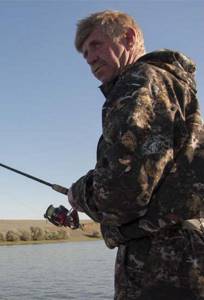
PROFESSIONAL JAGERS
Over the ten years of the base’s existence, a close-knit and responsive team has developed
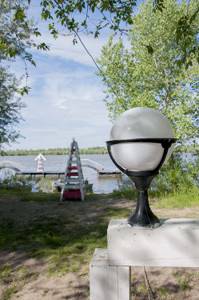
30 METERS FROM THE WATER
The recreation center is located directly on the shore of Akhtuba
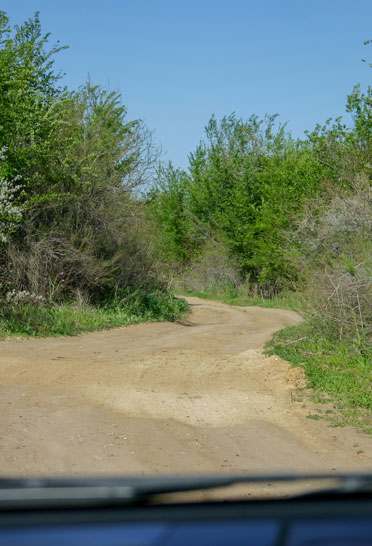
CONVENIENT ACCESS
There is access to the base all year round - both during high water and during spring thaw.
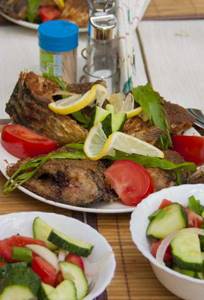
EXCELLENT KITCHEN
The local cafe serves delicious home-cooked food
Fishing methods
If a fisherman knows the preferences of the fish, its characteristics and habitats, then fishing for carp goes like clockwork. The fish is very careful, so it can be scared off by a slight noise or voice. It is better to catch sensitive fish by sailing from the shore on a rubber boat. Motor or metal boats are not an option, as they will scare away all the prey.
Although the carp is an omnivorous fish, it bites excellently on aromatic bait, depending on the time of year.
Types of bait:
- Worms;
- Locust;
- May beetle larvae;
- Shellfish;
- Canned corn;
- Barley, beans, peas;
- Semolina;
- Boiled potatoes;
- Boiled dough.
Vegetable oil can be used as a natural flavoring.
It is better if the bait creates turbidity in the water (bran, semolina, pearl barley, etc.). It is better to do it in advance so as not to rush before the trip, especially if fishing is planned for early morning.
If you don’t want to prepare your own bait, you can purchase flavored boilies at any fishing department. Artificial baits work no worse than home-made baits.
Catching carp is an active type of fishing, because you have to find the fish’s habitat, prepare or buy special bait, and feed the fish, preferably at dawn or sunset. Coming to the Volga for carp, even a beginner in fishing can come across trophy specimens.
TAGS:
Services for comfortable relaxation and fishing:

Boat rental
Our fleet includes more than 20 boats and boats equipped with Yamaha engines.

Gamekeeper services
A good huntsman is your personal assistant and a good fishing friend.
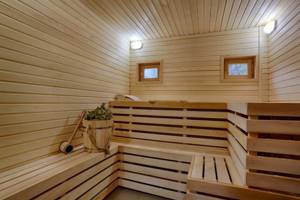
Bath
We invite you to visit a real Russian bathhouse, which will lift your spirits and restore strength after fishing.

Cafe-bar
In our cozy refectory you can have an inexpensive and, most importantly, tasty and nutritious meal.
Choosing bait
The closer winter approaches, the more nutritious the bait for carp should be. But in early September, when the weather is not so cool, plant baits are still used:
- Cake. It is a cake from plant seeds. For its preparation, ordinary seeds are used. You need to choose bait depending on the fishing location, so when fishing in still water it is better to take a soft product, and in a river it is as hard as possible.
- Porridge. The cereal is boiled and baked until it becomes very thick.
- Peas and corn. You can impregnate the nozzle with flavors.
- Boilies. You can purchase ready-made ones. The baits should be sinking, as carp usually feed from the bottom. You should take those products that have a bright and aggressive color.
- Berries. Before use, you need to remove the peel.
However, at the end of September the situation changes. It's getting colder. Carp needs to look for more nutritious food. That's why they use live bait:
- earthworm and dungworm,
- fry,
- maggot,
- crustacean meat,
- beetle larvae,
- bloodworm,
- leech.
Fishing for carp in August: gear and baits for catching carp in August
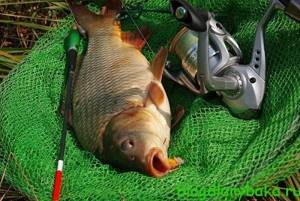
In this topic, I want to talk about how fishing for carp occurs in August. In August, the nights become cold, and the water temperature for fish habitat is more comfortable. Correctly determining the “point” for fish to feed, clear selection of gear and bait for catching carp in August is the key to success
Carp is one of the predominantly wary and powerful river fish, which gives a lot of trouble and vivid experiences when fishing. Makes daily and seasonal movements. Good knowledge of the reservoir and the art of finding where and when this fish feeds largely guarantees fishing success, which also greatly depends on the accuracy of the selection of tackle and bait. For the most part, I have had the opportunity to catch this fish on medium and large rivers with fairly strong currents, and here, in my opinion, all kinds of donk models are considered indispensable gear.
Places for catching carp
It is clear that the carp makes seasonal migrations associated with the search for feeding areas. With the arrival of not very favorable weather conditions, it lies in pits. In general, pits are the main habitat of large carp. At depth, carp prefers quiet, cool places with plenty of food. From here it goes out onto the channel edges, reaches and corresponding slopes downstream or upstream. Sometimes the carp feeds right in its den - in the pit. At this place, fishing is made easier by the fact that small fish are not disturbed. For example, on the Kama, Lower Volga, Akhtuba, and Lower Don, carp are caught in pits, the depth of which can reach 21 m. Experienced carp fishermen say that the time when this fish comes out to feed is not predictable. One day he can energetically take it before lunch, on another - after lunch, on the third - at dusk. Most fishermen agree that carp are least functional from 1 to 3 am, but even at this time, bites from large individuals sometimes occur. It is assumed that carp and catfish do not get along in the same pit. But that's not true. In the Lower Volga, carp are often caught along with catfish, if the donkey hook is baited with a pearl barley or toothless shell. In this case, in order not to find yourself “in the air” due to the unforeseen bite of the carp, increase the volume of the bait (the contents of two shells are placed on the hook at once) - after all, the catfish is more amenable to the offered tidbit. In general, it is necessary to take into account that any body of water has its own specifics and everywhere there are places that the carp loves everyone else, leaving them only in exceptional cases.
Carp nutrition
Carp eats plant and animal food available on the ground, algae, or carried away by the current. Thickets of water lilies, uruti, pondweed, elodea and reeds attract carp when they are hungry for an abundance of food. Here you can find crustaceans, leeches, nymphs, larvae of dragonflies, caddis flies, mollusks and other living creatures, and carp can come here to feed. Therefore, when fishing from an anchored boat on a bottom, if there are no carp bites in the pit, it is necessary to fish areas near algae that are close to great depths. Sometimes on warm summer evenings the carp comes out to frolic on the sandbanks. On large rivers, it often approaches the islands and stands below them on a dump, lying in wait for the current to bring it food washed away from the shore. And yet, the most common places are coastal areas with vegetation, snags, sunken trees and holes. For example, in the Lower Volga and Akhtuba, carp often choose deep water near sunken trees. It is preferable if a tree that has fallen from the shore has blocked the flow under the edge that separates the deep from the shallow water. Here, in the calm, the carp feels great, and the current always carries some food along the edge, which gets stuck in the branches of the water barrier. In the early and evening hours, carp prefers to feed near the shore, from which any living creature falls into the water. It often happens that he walks along the shallow edge. But he avoids edges where pike, catfish or pike perch are found in abundance. Less commonly, carp enter narrow, remote parts of reservoirs, bays and backwaters, especially if the bottom is muddy. It should be borne in mind that it looks for areas with warmer water and loves the surf shore if the wind is western or southern. The wind blows out small particles of food, the surface current carries them along the shore, and the wind also enriches the water with oxygen, which increases fish appetite, especially in summer.
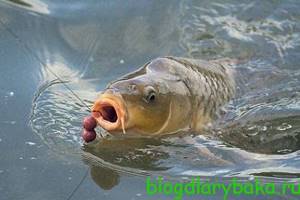
Catching carp from a boat
In deep and fast areas, it is most comfortable to fish from a boat. Usually it is installed on two anchors (one is thrown from the bow, the other from the stern). When fishing from a boat, the feeder is secured near the stern or bow, usually placing the bait in gauze or mesh, through which the feed is slowly washed away. You can also lower two feeders if there are two fishermen in the boat. The donka used in this case is quite simple. It is installed on a spinning rod with a test weight of up to 200 g or on a carp rod of similar load. Many people use old-fashioned metal spinning rods to catch carp from a boat, which are very strong and make it easy to control hooked fish. When fishing from a boat, you can completely equip the tackle with a Nevskaya type reel. Its brake is sufficient to withstand the strongest currents when using thick monofilament. By the way, for large carp, fishermen of the Lower Volga install a main line with a diameter of up to 1 mm. I think this is useless. With mobile gear, it is more comfortable to fish with a fishing line with a diameter not exceeding 0.6 mm. At the end of the rig there is a sliding sinker weighing 180–200 g, after which there is a leash 30–40 cm long. The weight of the sinker is especially important to take into account when casting at 15–20 m, if fishing happens in such fast-water holes as are present in the Lower Volga. Otherwise, the sinker lifts and the nozzle does not touch the bottom. With a sinker weighing 100–150 g, casts must be made 30–40 meters from the boat, then the equipment will have a greater chance of being pressed to the bottom. It is not appropriate to use braided leashes on a strong current, especially when fishing for shell meat, since the bait here acts like a propeller, strongly twisting the line. But for the main fishing line, on the contrary, it is better to take braided line, since it is not easily blown out by the current. For carp donka, a braid with a diameter of 0.15–0.18 mm is useful.
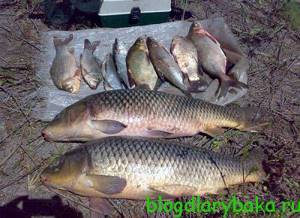
For bottom fishing for carp, hooks No. 1–3/0 according to the international classification are used. They use both hooks with a barb and a sting, directed synchronously with the fore-end, and away from it. It is believed that the latter is more grippy. Experienced fishermen take with them when fishing a set of ready-made leashes with hooks, which are held on a compact reel. In the event of a break, such a leash can be easily attached to a carabiner, which, together with the swivel, blocks the sliding sinker. It is recommended to take in stock a certain number of leashes at once, differing from each other in thickness and hook size. By changing leashes depending on the fishing criteria or bait, you can choose the best hook . Some fishermen of large rivers with strong currents equip carp donks with feeder feeders. They can be spiral or mesh and installed on the main line using different techniques. The simplest is to place the sliding feeder on the main line above the diamond-shaped sliding sinker. This sinker is excellent because it does not fly off the bottom in a strong current. Fishermen of the Don and Lower Volga use flat frame weights with sliding lugs in connection with sliding feeders. The leash in such a system also closes the rig. In addition, metal mesh feeders are mounted with anti-twist tubes installed above the sliding sinker. Along with the above equipment, in the current from a boat they fish with a cake plate with many leads, which I will talk about below. As a rule, a bite alarm is not required when fishing from a boat. If your “stick” is equipped with a “Nevskaya” type reel, then the latter will signal a bite with a ratchet. I must say that the carp takes the current confidently. He tries the bait for a short time and soon grabs the bait and confidently moves away with it. The hooking must be proactive. When fishing for a large carp, you need to spend a lot of time and remove unnecessary gear, otherwise it will become entangled with fish.
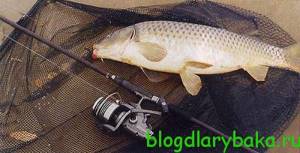
Catching carp from the shore
has its merits. It’s comfortable to cast from here if the riverbed is located nearby. In this case, it is enough to have carp rods 2–2.5 m long with 120–200 g of dough, equipped with a fairly powerful inertial or inertial-free reel. If the habitats of the carp are located at a considerable distance, they use rods with a test weight of up to 200 g and a length of 3–3.6 m. With such sticks, it is possible to cast carp equipment at a distance of up to 80 m. Traditionally, they fish from the shore with several bottoms at once. It is better if each donk is equipped with a small wire mesh or spring feeder. However, to lure carp, you usually need a lot of food, so where beavers specialize in carp, they use feeders designed for at least 200 g of bait. It’s difficult to throw heavy feeders over a long distance even with today’s carp fishing rods, so donks equipped with such feeders are delivered by boat. This is usually done in pairs. One fisherman stands on the shore and releases the tackle, unwinding the fishing line from the reel, the other takes the feeder to a given “point” on a boat and releases it into the water, making allowances for the current, which will carry the equipment to the required place. The most experienced fisherman usually delivers several bottoms at once, taking on board from 3 to 5 feeders, and, according to the fishing rods placed on the shore, sequentially releases them into the water. When catching carp, covered container-type feeders with holes on the sides are used relatively rarely. Filled with maggots, they can be useful in quiet areas. However, some fishermen fill them with fine-grained plant food and use them where there is a strong current. The weight for any feeder is chosen so that it quickly pulls the feeder to the bottom and allows you to make a long cast.
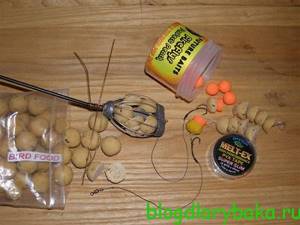
Boilies for catching carp
Most often used when fishing for carp in areas with weak currents. Boilies make it possible to cut off small items and store aromatic additives for a long time. The Russian carp, which is not accustomed to boilies, requires long-term baiting with bait boilies. But then, having tried this type of food properly, he takes it very willingly. My friends in the Lower Volga have tested the effect of boilies on carp. In particular, the famous carp angler S. Matkovsky constantly catches trophy carp in the Enotaevka area and other places. Other boilie fishing specialists whom I met on the river. Kharabalyk, they told me that they need to feed up to 5 kg of bait boilies per day. It usually takes up to three days to attract a trophy carp to a site. During currents it is better to use heavy boilies. The composition of baited boilies depends on the composition of the boilies that were fed. Very promising are boilies made from a mixture of birdseed, which can be easily ground in a coffee grinder, with the addition of sunflower or soybean oil for elasticity of the dough. Such mixtures are called Birdfood. Boilies containing some stimulants - dry substances that stimulate the appetite and possess not only the aroma, but also the taste of meat or plant components - work well for carp. Add them immediately to the dry mixture before mixing it. For example, for the southern carp, positive results were given Fruit (fruit) - apple, strawberry, pear and Sweet (candies, sweets) - sugar, all kinds of caramel mixtures, etc. For 1 kg of dry boilie mixture, 50-100 g of stimulants are used. Substances with different aromatic qualities should not be added to the mixture - the smell should be uniform. For spot feeding, some nurseries use so-called soluble fishing line, on which boilies are strung. Having landed in the water, such a fishing line begins to disappear, and the balls scatter from the garland along the bottom. A fishing line with a garland of boilies can be tied to a hook and thus among the freed bait there will be one boilie with a hook. This method is very good when the carp is energetically looking for food, all the time moving around the reservoir. Boilies can be used as bait and bait when fishing from a boat, as well as from the shore using bottom tackle.
Here are the ingredients for making boilies:
Option I: soy flour - 25%; semolina -20%; corn flour -10%; ground peas - 10%; ground birdseed - 10%; milk powder -15%; casein -10%.
Option II: milk powder - 20%; corn flour - 15%; ground hemp - 20%; semolina - 25%; fishmeal -15%; casein - 5%.
Option III: soy flour - 30%; ground peas - 20%; wheat flour - 10%; starch - 10%; ground hemp - 10%; ground peanuts -10%; milk powder -10%.
IV option: soy flour - 20%; fishmeal - 10%; crab shell flour - 15%; semolina -20%; casein -15%; wheat gluten -10%; mashed new potatoes -10%.
When fishing with boilies, electric sound bite alarms of the “rod-pod” type are used. These innovative devices automatically disengage when hooking, and the carp, which is very cautious in calm waters, does not feel the slightest resistance, so it fearlessly takes the bait. And further. If you equip the carp with a completely modern tackle, then the sinking material Kryston Merlin, which falls to the bottom, repeating its relief, and does not hang in the water, is well suited for the leash. The latest developments in this area are braided lines of the Shake-skin type (literally: “Shedding skin”). They are covered with a shell that is easy to remove. In this case, you can create a number of sections with different softness on one leash.
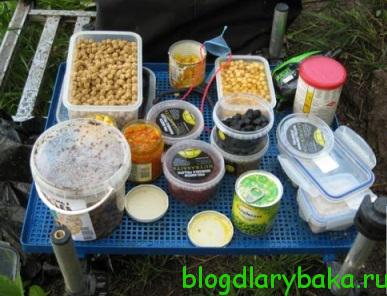
Nozzles for catching carp
Steamed wheat, peas, corn. Carp take these baits in the summer in most reservoirs. They are prepared quite simply. The raw materials are poured into an enamel pan or cast iron and left to swell for a day. Then the water is drained, again filled with heated water 1.5-2 cm above the surface of the grains and, covered with a lid, placed in the oven or oven. After 2-3 hours of languishing, the profit is ready. The grains are placed on a forged hook with a short shank, 4-5 pieces each.
Steamed pearl barley Another favorite bait for carp. It is prepared quite simply. The grains are poured into a not very large enamel pan, poured 1.5-2 cm above the level, covered with a lid and simmered over low heat. From time to time the grains need to be stirred. In case of strong boiling, water may be added slightly. The nozzle is considered ready when the water has boiled away by more than half and the grains have become soft and elastic. In addition, it is very convenient to “steam” pearl barley in a thermos. To do this, pour a tenth of its volume of cereal into a thermos and fill it with boiling water to the top. In 2-3 hours the nozzle will be ready.
Potatoes You can take young potato “peas”. It is prepared in highly salted water, which must then be immediately drained. After which the potatoes are poured with cool water and immediately drained again. Repeat this procedure until the potatoes have cooled. The cooled potatoes are cut into slices with a volume of 10-15 mm and the attachment is ready. Boiled potatoes can also be used as a component for a more complex composition. To do this, the pulp of wheat bread is fried and crumbled into a plate. Freshly boiled and peeled hot potatoes are also placed here. Bread and potatoes are taken in approximately the same proportions. By rubbing the contents of the plate with a pestle until smooth, you get a kind of dough, which is then kneaded with your hands. In this case, you need to add any vegetable oil and, preferably, some kind of flavoring to the dough. Thanks to the oil that envelops the dough, the attachment made in this way does not dry out for a long time, and wrapped in a wet cloth it can remain in working condition even in the hottest time for about 2-3 days. White bread can be replaced with rye bread. Then the milky white or slightly yellowish color of the bait will change to gray, but in any case, the ball from it will stay on the hook for a long time and will not be washed away even by a fairly strong current.
Cake A very famous bait for catching carp in the southern regions of Russia and Ukraine. Probably, the carp there is accustomed to oil cake because of the abundance of sunflowers in the fields, the seeds of which fall into the water with the wind. Sunflower cake should be hard, but fresh - then when it stays in water it will not get wet for a long time. The cake is taken in the form of a not very large square or plate and it requires special equipment. Its basis is a bent lead mold the size of the cake plate, tied to the end of the main fishing line. The cake is securely pressed to the plate with rubber bands. Holes for leads (from 3 to 5) are constructed on the front edge of the plate. Leashes 15-20 cm long are made of monofilament with a diameter of 0.5-0.6 mm or from braid with a diameter of 0.15-0.17 mm, but it is best to make them from nylon thread. The hooks tied to the leashes are driven into the cake plate. This attachment is interesting in that small change does not fit into it.
Worm, crawler A bunch of red worms of the sublist type or crawler works well for carp when it is vigorously caught in deep carp holes, where there are no small fish in sight. Otherwise, the bream, roach and other fish will instantly tear off the bait and fishing will become impossible. For a bunch of worms and a crawl, hooks No. 1-3 are suitable.
Malek It is clear that in southern reservoirs, poor in food, carp can feed on young fish. The fry is baited when fishing on the bottom. Usually, two fry are baited on hook No. 1-3/0 at once, usually with a stocking through the mouth. In the Astrakhan and Volgograd regions, carp farmers sometimes even use heavy jigs with fry.
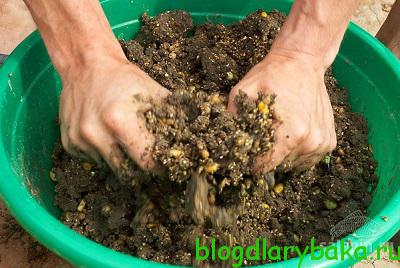
Bait for carp
Carp are usually fed with the same thing that they intend to catch with: if using a worm, then chopped worms; if using vegetable baits, then with breadcrumbs or balls prepared from various mixtures of vegetable origin.
If the current makes it possible to use large mesh feeders loaded with stones, then bait in the form of all kinds of bait balls can be placed in them to attract carp. For example, the “old-fashioned” bait of chopped worms rolled into balls based on loam, which should be evenly eroded by the current, works great. Worms are good because their special smell attracts carp from afar. Even in the southern regions, they use balls containing shell meat. To do this, the pulp is removed from the shell, finely chopped or pounded into a porridge-like mass - crushed shell flaps can be added to it. All this is mixed into the coastal soil with the addition of clay to create the appropriate viscosity and balls the size of an apple are made. The amount of viscous substance added depends on the speed of the flow - the stronger it is, the more resistant the balls are to erosion. The bait made by this method is placed in a loaded net and lowered from the side of the boat to the bottom, the end of the rope is tied to the stern. In addition to this, balls of hard-cooked semolina porridge with the addition of sunflower cake proved to be excellent. This bait is prepared as follows: ground cake is mixed with breadcrumbs, industrial bait and semolina, then the resulting powder is poured into slightly heated oatmeal and stirred thoroughly until it reaches a suitable thickness. Semolina is a connecting element.
For a feeder used in strong currents, we can recommend the following mixture: breadcrumbs -25%; oatmeal - 25%; bran - 20%; cake -15%; crushed hemp seeds - 10%; milk powder -5%.
When fishing away from a fast stream and in bays where the bait washed away from the feeder is not carried away by the current, the consistency of the bait material is achieved such that its small particles form a long-lasting suspension and, dissolving, carry the aromatic smell far in the water. To do this, the content of baby oatmeal in the bait is reduced to 5-10%, and the amount of loose cake and breadcrumbs, on the contrary, is increased. As for bran, it is better to take it coarsely ground - then small grains, breaking away from the main mass, will form a cloudy suspension or they will be carried over a longer distance by the current. Before introducing bran into the bait, they are steamed for a long time over low heat. The bait, which produces a cloudy suspension, is made on the basis of corn flour. Corn flour is poured into a container with boiling water and stirred until a thick mass is formed. The porridge prepared in this way must be kept in a woolen or cotton blanket, and when it cools, mix with a small amount of mashed potatoes and add a little butter or anise for flavor. Such bait in the water breaks up into separate particles, producing turbidity, which is attractive to carp. Don't forget to subscribe and receive the latest posts in your email with respect, blog author

